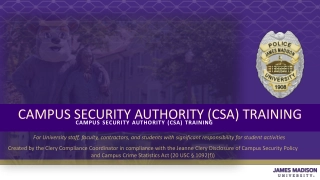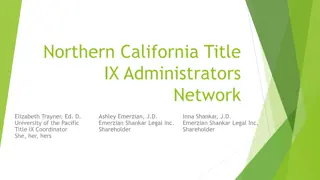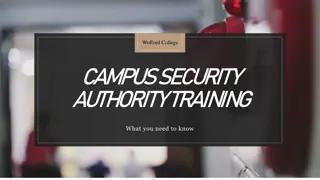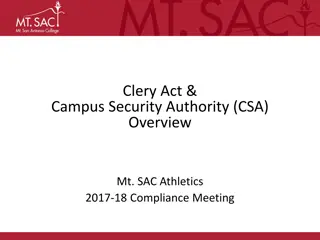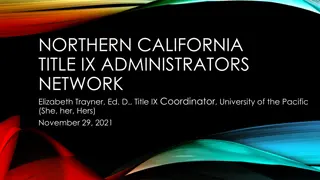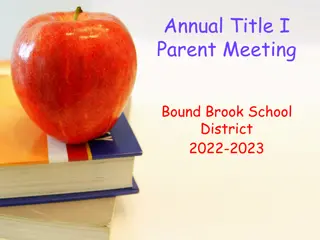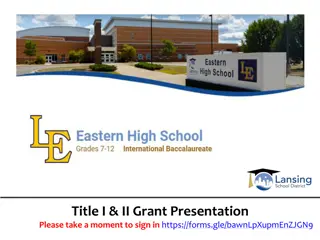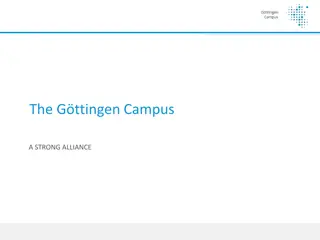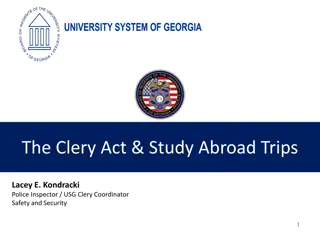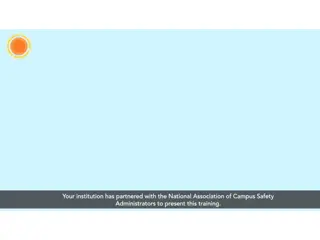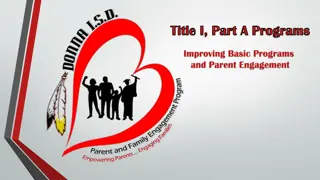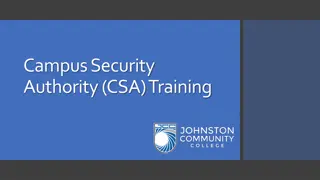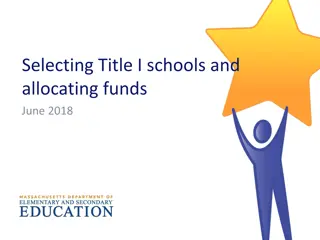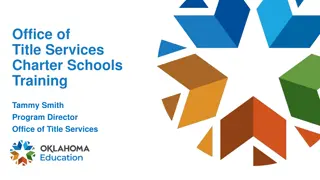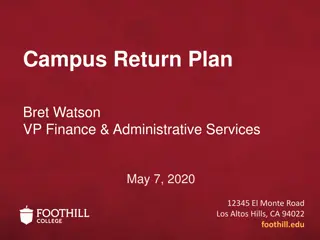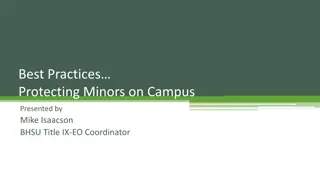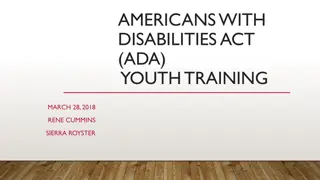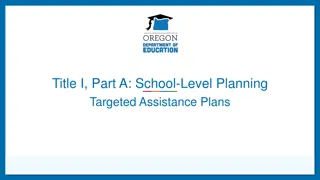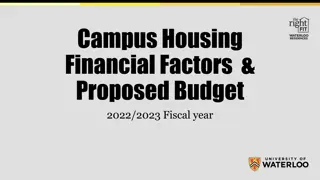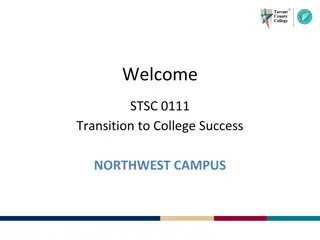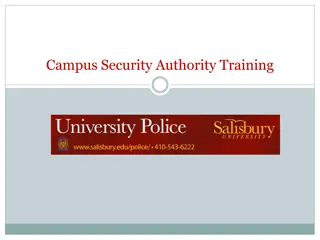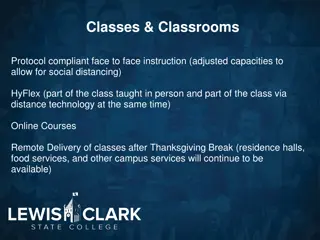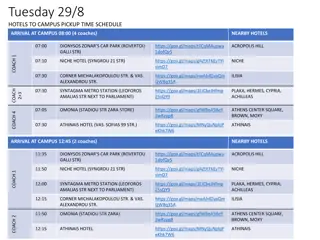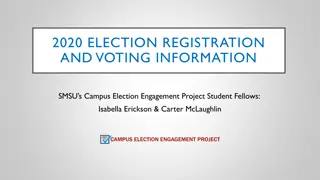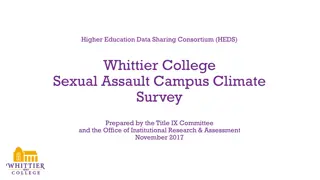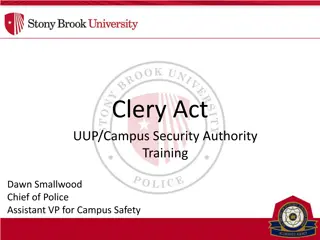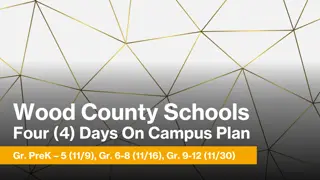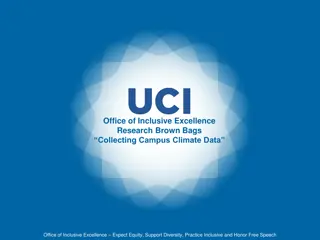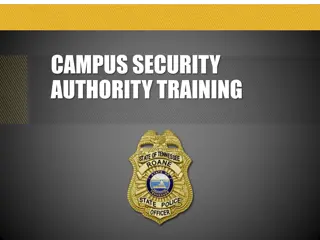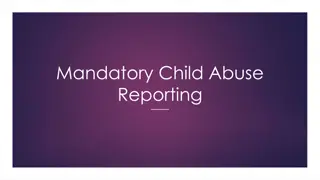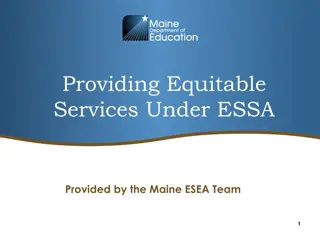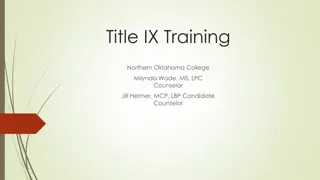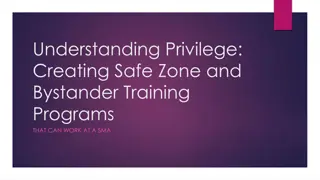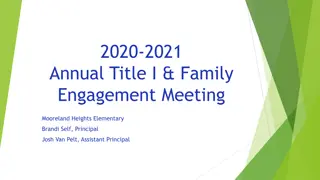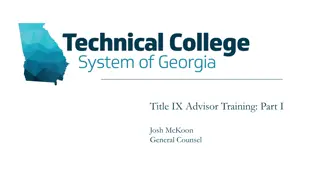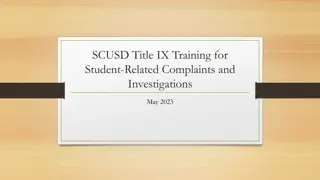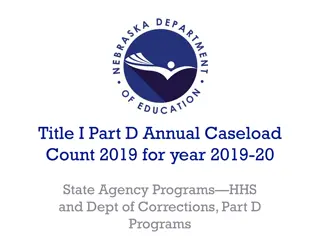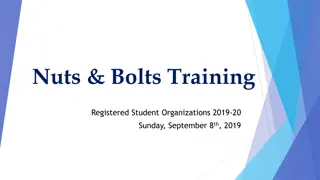Campus Responsibilities under Title I, Part A Programs
Title I, Part A programs aim to address the needs of at-risk children by providing financial assistance to Local Education Agencies (LEAs) and campuses serving economically disadvantaged students. Campuses can operate either a schoolwide program or targeted assistance to raise academic achievement. Monitoring effectiveness is crucial, requiring the Texas Education Agency (TEA) to oversee program operations and recommend School Support Teams for compliance. Members of the SST include qualified educators and specialists to ensure program effectiveness and student performance alignment with state and federal expectations.
Download Presentation

Please find below an Image/Link to download the presentation.
The content on the website is provided AS IS for your information and personal use only. It may not be sold, licensed, or shared on other websites without obtaining consent from the author. Download presentation by click this link. If you encounter any issues during the download, it is possible that the publisher has removed the file from their server.
E N D
Presentation Transcript
Introduction These programs help ensure that the needs of children who are failing, or most at risk of failing to meet the state s challenging student academic standards and assessments are addressed The purpose of Title I, Part A is to provide financial assistance to Local Education Agencies (LEAs) and campuses that serve high percentages or high numbers of economically disadvantaged children NCLB Title I, Part A Campus Responsibilities 1
Schoolwide Campus Title I campuses with percentages of students from low-income families of at least 40% may use Title I funds, along with other federal, state and local funds and may operate a schoolwide program to: Raise academic achievement for ALL students Upgrade the entire educational program NCLB Title I, Part A Campus Responsibilities 2
Targeted Assistance The campus identifies a select group of students who are failing, or most at risk of failing to meet the state s challenging academic achievement standards, and designs an instructional program to meet their needs Title I campuses with less than 40% of students from low-income families or that choose not to operate a schoolwide program can operate a targeted assistance program NCLB Title I, Part A Campus Responsibilities 3
Monitoring Effectiveness Federal law requires the Texas Education Agency (TEA) to monitor the operation of Title I, Part A programs Title I, Part A campuses are also recommended to have a school support team (SST) consisting of two to three members, including a district level contact, to monitor program compliance, effectiveness, and most importantly how students served through the program are meeting the state and federal expectations for performance NCLB Title I, Part A Campus Responsibilities 4
Monitoring Effectiveness Who are members of an SST? Highly Qualified or distinguished teacher and principal Pupil services personnel Qualified consultants from Math, ELA and Science Any Title I specialists NCLB Title I, Part A Campus Responsibilities 5
Funding The most recent Census update and the annual update of neglected and foster home children are used for this calculation TEA allocates Title I, Part A funds by using a statutory formula that the Census Bureau provides with LEA estimates of poor, school-age children NCLB Title I, Part A Campus Responsibilities 6
Funding These services must be in addition to the regular services normally provided by an LEA or campus for participating children Title I, Part A funds are to be used to provide supplemental services. NCLB Title I, Part A Campus Responsibilities 7
Funding Any program activity required by state law, State Board of Education (SBOE) rule, or local board policy may not be funded with Title I, Part A funds In addition, state or local funds may not be decreased or diverted for other uses merely because of the availability of these funds NCLB Title I, Part A Campus Responsibilities 8
Funding Campus Administration: Must be knowledgeable about the campus budget and must have provided input on how funds are to be expended Must be knowledgeable about allowable and unallowable costs and the use of funds for Title I, Part A campus allocations NCLB Title I, Part A Campus Responsibilities 9
Funding Campus Administration: Must also ensure that the funds allocated to the campus for parent involvement activities are expended to improve family and community engagement, i.e., parent involvement NCLB Title I, Part A Campus Responsibilities 10
Funding Title I, Part A funds must be supplemental (in addition to) the equitable amount of state and local funds allocated to the campus and used to upgrade the entire educational program on a schoolwide campus Schoolwide Program: NCLB Title I, Part A Campus Responsibilities 11
Funding Targeted Assistance Program: Title I, Part A funds may only be used to meet the needs of children identified as being in greatest need of services Students must be selected using multiple, educationally related, objective criteria established by the LEA The program, activity, or strategy must be supplemental NCLB Title I, Part A Campus Responsibilities 12
Funding Records must be maintained that document that Title I, Part A funds are expended on activities and services for only Title I, Part A eligible children identified as having the greatest need for special assistance Targeted Assistance Program: NCLB Title I, Part A Campus Responsibilities 13
Funding Campus Administration must be able to respond appropriately to and maintain documentation for specific questions to determine if an expenditure would be allowable Refer to page five of the resource, NCLB Title I, Part A Allowable & Unallowable Costs, for six questions that campus administrators need to be able to answer when budgeting Title I, Part A funds. Resource available from: http://www.region10.org/capacity-building- initiative/capacity-building-links/nclb- publications SW Campus Expenditures NCLB Title I, Part A Campus Responsibilities 14
Funding Schoolwide campuses have some additional Flexibility options available for consolidation of funds: Allows pooling of funds Promotes greater flexibility in the allowable use of funds. The Texas Education Agency maintains a webpage dedicated to Schoolwide Flexibility: http://tea.texas.gov/grants/schoolwideprogr ams/ Schoolwide Flexibility Options NCLB Title I, Part A Campus Responsibilities 15
Funding These changes were established to: Reduce waste, fraud, and abuse Improve consistency among federal grants; Increase efficiency and oversight The Texas Education Agency has established a webpage dedicated fully to this topic: The_New_EDGAR The New EDGAR NCLB Title I, Part A Campus Responsibilities 16
Funding The Title I, Part A Allowable and Unallowable Costs resource and the Fiscal Requirements resources provide additional information: These resources are located at the following link: http://www.region10.org/capacity-building-initiative/capacity- building-links/nclb-publications/ NCLB Title I, Part A Campus Responsibilities 17
Highly Qualified Staff Section 1119 of the Elementary and Secondary Act (ESEA) focuses on improving teacher and paraprofessional quality at the local level Teachers are required to be highly qualified (HQ) if they are the Teacher of Record providing direct instruction to students in any core subject area NCLB Title I, Part A Campus Responsibilities 18
Highly Qualified Staff English Reading or language arts Mathematics Science Foreign languages Civics and government Economics, History Geography Arts Core Academic Subject Areas: NCLB Title I, Part A Campus Responsibilities 19
Highly Qualified Staff Courses that are outside of the core academic subject areas (including some Career and Technical Education Courses and some Technology Application Courses) that are accepted by SBOE for graduation credit in a specific core academic subject area require the teacher of record to be highly qualified NCLB Title I, Part A Campus Responsibilities 20
Highly Qualified Staff At the beginning of each school year, the district must notify the parents of each student attending any school receiving Title I, Part A funds that the parents may request information regarding the professional qualifications of the student s classroom teachers This is sometimes referred to as The Right to Know notification NCLB Title I, Part A Campus Responsibilities 21
Highly Qualified Staff Right to Know Notification should include: Whether the teacher has met the state qualifications and licensing criteria Whether the teacher is teaching under an emergency or other provisional status Right to Know The type of degree and certification the teacher has Whether the child is provided services by paraprofessionals, and if so, what their qualifications are NCLB Title I, Part A Campus Responsibilities 22
Highly Qualified Staff Campus Requirements: Campus administrators should work with district staff to hire highly qualified teachers in core academic subject areas. (This also applies to campuses not served with Title I, Part A funds if the district receives Title I, Part A for any of its campuses) NCLB Title I, Part A Campus Responsibilities 23
Highly Qualified Staff Campus Requirements: The principal of each campus must attest, in writing (Principal Attestation) as to the status of each campus being in compliance with the requirements for highly qualified teachers Copies of the signed attestation forms need to be on file at the campus level and at the district level A sample attestation is available on TEA s NCLB website at the following link: Principal Attestation NCLB Title I, Part A Campus Responsibilities 24
Highly Qualified Staff Campus Requirements: If a campus does not have 100% core academic subject area classes taught by highly qualified teachers, the campus is required to complete a Highly Qualified Continuous Improvement Plan (HQTCIP) detailing actions that will be taken to assist the not HQ teacher in becoming highly qualified for that assignment Templates for required Highly Qualified Plans are located on the TEA NCLB website at the following link: HQTCIP NCLB Title I, Part A Campus Responsibilities 25
Highly Qualified Staff Parent Notification for any teacher NOT HQ: The campus principal must also provide timely written notice to the parent if the parent s child has been assigned or has been taught for four or more consecutive weeks by a teacher who is not highly qualified A template of this letter is available on the TEA NCLB website at the following link: Parent Notification NOT HQ NCLB Title I, Part A Campus Responsibilities 26
Highly Qualified Staff On a Title I Schoolwide campus - all paraprofessionals that perform instructional support duties must be HQ, without regard to whether the position is funded with federal, state, or local funds HQ Paraprofessionals On a Targeted Assistance campus only paraprofessionals who perform instructional duties and are funded through Title I, Part A must be HQ NCLB Title I, Part A Campus Responsibilities 27
Highly Qualified Staff To be HQ, paraprofessionals who perform instructional duties in a Title I, Part A program must: Have completed 2 years of study at an institution of higher education (defined as 48 semester hours) or Have obtained an associates degree; or Have met a rigorous standard of quality and can demonstrate, through a formal state or local assessment knowledge and ability to assist in instruction NCLB Title I, Part A Campus Responsibilities 28
Highly Qualified Staff The campus principal must ensure that paraprofessionals who provide instructional support are working under the direct supervision of a highly qualified teacher The campus and the district must have copies of the list of paraprofessionals and designated teachers NCLB Title I, Part A Campus Responsibilities 29
Highly Qualified Staff The NCLB Highly Qualified Resource can provide additional information. The resource is located at the following link: NCLB Publications NCLB Title I, Part A Campus Responsibilities 30
Comprehensive Needs Assessment and Planning The Elementary Secondary Education Act (ESEA) statute requires that each funded program conduct a comprehensive needs assessment to determine priorities for the intended program recipients Districts and campuses are required to use the results of the comprehensive needs assessment to develop the comprehensive plan and program NCLB Title I, Part A Campus Responsibilities 31
Comprehensive Needs Assessment and Planning For both Schoolwide and Targeted Assistance Campuses, the CNA should examine: Performance of children in relation to state content and student performance standards ALL students, as well as required subgroups: Economically Disadvantaged students, students from major racial and ethnic groups, students with disabilities, students with limited English proficiency, and Migratory students NCLB Title I, Part A Campus Responsibilities 32
Comprehensive Needs Assessment and Planning A Title I, Part A campus plan should be: Developed with the involvement of parents and other community members, and individuals who will carry out the plan (administrators, teachers) Made available to the district, parents, and the public, and the information contained in the plan should be in an understandable and uniform format NCLB Title I, Part A Campus Responsibilities 33
Comprehensive Needs Assessment and Planning The Comprehensive Needs Assessment resource can provide additional information. The resource is located at the following link: NCLB Publications NCLB Title I, Part A Campus Responsibilities 34
Parent Involvement/Family and Community Engagement Parents, families, educators, and communities form a partnership and are accountable for improving student achievement by fully participating in the education of all children Partnership is defined as the participation of parents in regular, two-way, and meaningful communication involving student academic learning and other school activities NCLB Title I, Part A Campus Responsibilities 35
Parent Involvement/Family and Community Engagement Convene an annual meeting at a convenient time All parents of participating children are invited and encouraged to attend Offer flexible meeting times (morning or evening) These parents are to be informed of their child s participation in Title I and of the parent s right to be involved Requirements for Parental Involvement Meetings: NCLB Title I, Part A Campus Responsibilities 36
Parent Involvement/Family and Community Engagement Campus requirements for parental involvement: Parents must be informed about curriculum, assessment, and proficiency levels students are expected to meet Campuses must provide assistance to parents, as appropriate, in understanding such topics as the state s academic content standards and the state and local academic content standards NCLB Title I, Part A Campus Responsibilities 37
Parent Involvement/Family and Community Engagement Campus requirements for parental involvement: Provide materials and training to help parents work with their children to improve their student s achievement (includes literacy training) Coordinate, to the extent feasible and appropriate, with other programs Head Start, Title III, etc. to discuss the developmental and other needs of individual children NCLB Title I, Part A Campus Responsibilities 38
Parent Involvement/Family and Community Engagement Campus requirements for parental involvement: Provide information related to school and parent programs, meetings and other activities in a language understandable by parents of participating children Provide such other reasonable support for parental involvement activities that parents may request NCLB Title I, Part A Campus Responsibilities 39
Parental Involvement Policy The PI Policy is required for each Title I funded LEA and campus It defines how the LEA or campus will meet parent involvement/family and community engagement requirements NCLB Title I, Part A Campus Responsibilities 40
Parental Involvement Policy The Parental Involvement Policy: Is developed with and distributed to parents of participating children Is incorporated into the Title I, Part A campus plan States how parents will be involved in planning, reviewing, and improving programs, including the parent involvement policy NCLB Title I, Part A Campus Responsibilities 41
Parental Involvement Policy The Parental Involvement Policy: Includes descriptions and explanations of curriculum, assessment, and proficiency expectations Includes how the campus will be responsive to parents requests to participate in their child s education NCLB Title I, Part A Campus Responsibilities 42
Parental Involvement Policy Includes how parents may have input on the plan including submitting complaints if not satisfactory Builds capacity toward a strong parent, family, and community program Provides for annual evaluation of content and effectiveness including identification of barriers to participation by any particular ethnicities or economic groups The Parental Involvement Policy: NCLB Title I, Part A Campus Responsibilities 43
Parental Involvement Policy When developing the campus parental involvement policy, campuses are required to address specific activities Please refer to page 16 of the resource for these activities Additional information and a PI Policy toolkit are also available at Reg 16 Statewide Initiatives PI Campuses may also address additional activities. NCLB Title I, Part A Campus Responsibilities 44
School-Parent Compact parent compact to clarify what families and schools will do to ensure that students reach high academic achievement standards The requirement to develop the compact is applicable for all Title I Schoolwide and Targeted Assistance programs NCLB Title I, Part A Campus Responsibilities 45
School-Parent Compact The school-parent compact must be jointly developed by the campus with the involvement of parents of participating children. The school-parent compact should outline how parents, school staff, and students will share responsibility for improved student achievement The compact will also outline the means by which the school and parents will build and develop a partnership to help children achieve high academic standards NCLB Title I, Part A Campus Responsibilities 46
School-Parent Compact Each campus must ensure that the school-parent compact: Describes the school s responsibility to provide high-quality curriculum and instruction in a supportive and effective learning environment Describes the ways in which all parents will be responsible for supporting their children s learning Additional information regarding the PI School-Parent Compact is also available from the Region 16 Statewide Initiative Live Binder , located via this link: Five Steps to Success For Developing School-Parent Compacts NCLB Title I, Part A Campus Responsibilities 47
School-Parent Compact Each campus must ensure that the school-parent compact addresses the importance of ongoing communication between teachers and parents on a regular basis through, at a minimum: Annual parent-teacher conferences in elementary schools during which the compact shall be discussed in relation to the child s achievement NCLB Title I, Part A Campus Responsibilities 48
School-Parent Compact Frequent reports to parents on their children s progress Each campus must ensure that the school- parent compact addresses the importance of ongoing communication between teachers and parents on a regular basis through, at a minimum: Opportunities to volunteer and participate in their child s class Reasonable access to staff Observation of classroom activities NCLB Title I, Part A Campus Responsibilities 49
Schoolwide Planning Schoolwide Programs Address the educational needs of economically disadvantaged students with comprehensive strategies for improving the whole school so every student achieves at high levels of academic proficiency Do NOT have to identify particular children as being eligible for services NCLB Title I, Part A Campus Responsibilities 50


